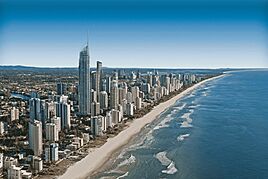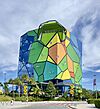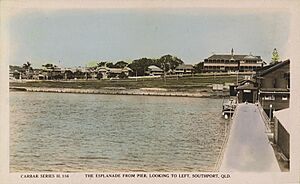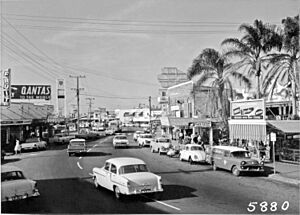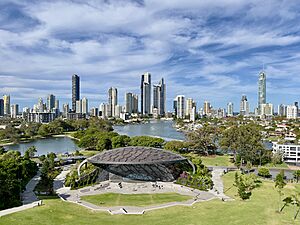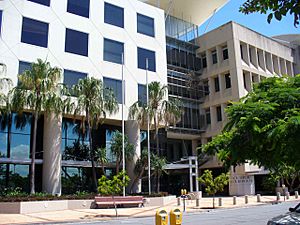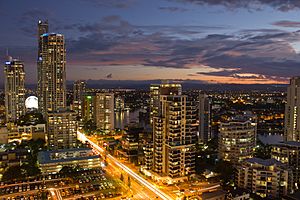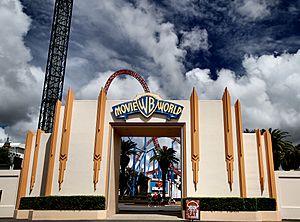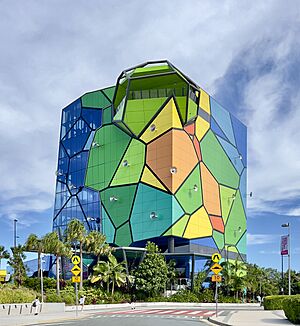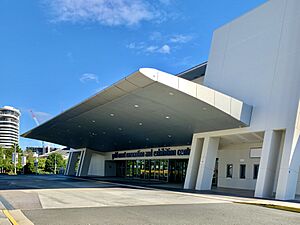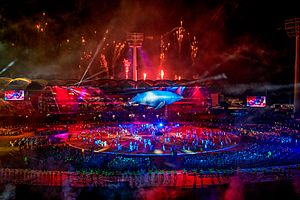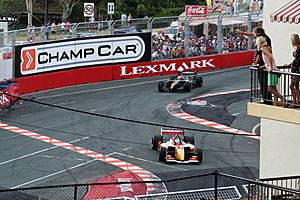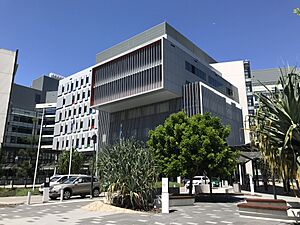Gold Coast, Queensland facts for kids
Quick facts for kids Gold CoastQueensland |
|||||||||
|---|---|---|---|---|---|---|---|---|---|
|
Q1 and the Gold Coast skyline
Isle of Capri
Light rail on Surfers Paradise Boulevard
Chevron Renaissance
Roxy Theatre at Warner Bros. Movie World
|
|||||||||
| Population | 640,778 (2021) (6th) | ||||||||
| • Density | 972/km2 (2,520/sq mi) | ||||||||
| Established | 1865 | ||||||||
| Area | 414.3 km2 (160.0 sq mi) | ||||||||
| Time zone | AEST (UTC+10:00) | ||||||||
| Location | 66 km (41 mi) SSE of Brisbane | ||||||||
| LGA(s) | City of Gold Coast | ||||||||
| State electorate(s) |
|
||||||||
| Federal Division(s) | |||||||||
|
|||||||||
The Gold Coast, also known as GC, is a coastal city in Queensland, Australia. It is about 66 kilometres (41 miles) south-southeast of Brisbane, the state capital. The Gold Coast is Queensland's second-largest city after Brisbane. It is also Australia's sixth-largest city and the biggest city that is not a state capital.
The city's main business area is in Southport. The Gold Coast stretches almost 60 kilometres (37 miles) along the coast. It connects with the Greater Brisbane area to the north and the New South Wales border to the south. People who live here are called Gold Coasters.
The Gold Coast area was originally home to the Yugambeh people. The city grew from small towns, with Nerang being the first in 1865. Tourism helped the region grow a lot from the 1920s. By 1959, the Gold Coast became a city. Its first skyscraper was built in 1960. The city grew very quickly from the 1980s onwards, with many tall buildings being constructed.
Today, the Gold Coast has a strong economy. Key areas include health, tourism, arts, culture, and construction. The city is known as a creative hub. It has a growing video games industry and leads Australia in new startup businesses. The Gold Coast is also a major centre for film and television production. This has earned it the nickname "Goldywood." It hosts the AACTA Awards and the Gold Coast Film Festival.
The Gold Coast is a popular tourist destination. It has a sunny, subtropical climate. It is famous for its surfing beaches like Surfers Paradise. It also has many high-rise buildings, theme parks, exciting nightlife, and beautiful rainforest in the hinterland.
Contents
History of the Gold Coast
The Gold Coast is the traditional land of several Indigenous clans of the Yugambeh people. These include the Kombumerri, Mununjali, and Wangerriburra clans. Europeans first arrived in 1823 when explorer John Oxley explored the Tweed River. People were drawn to the area in the mid-1800s for its timber.
Small towns grew along the coast and inland. Nerang was set up in 1865 as a base for the timber industry. By 1873, Burleigh Heads was also surveyed. In 1875, a small settlement at the mouth of the Nerang River was surveyed and renamed Southport. Southport quickly became a quiet holiday spot for wealthy people from Brisbane.
After World War One, many "seaside shacks" appeared. These were cheap, simple homes for coastal getaways. They were often built from recycled materials like old timber or even disused trams.
The Gold Coast region grew a lot after the Surfers Paradise Hotel opened in the late 1920s. The area was first called the South Coast because it was south of Brisbane. But property prices became very high. So, people started calling it the "Gold Coast" in 1950. Locals first thought this name was negative. However, "Gold Coast" soon became a common way to describe the holiday strip from Southport to Coolangatta.
The Town of South Coast was formed on June 17, 1949. It combined the towns of Coolangatta and Southport with coastal areas from the Shire of Nerang. This made the current Gold Coast coastal strip one local government area. As tourism grew in the 1950s, businesses started using "Gold Coast" in their names. On October 23, 1958, the Town of South Coast was renamed the Town of Gold Coast. Less than a year later, on May 16, 1959, it was officially declared a city.
The area boomed in the 1980s as a top tourist spot. In 1994, the City of Gold Coast local government area grew to include the Shire of Albert. In 2007, the Gold Coast became Australia's sixth-largest city. It was also the largest city that was not a state capital. The Gold Coast hosted the 2018 Commonwealth Games.
Gold Coast Population
In 2016, the Gold Coast urban area had 540,559 people. Including rural areas, the population was 569,997. The average age was 39 years old. Most people (64%) were born in Australia. Other common birthplaces included New Zealand (7.9%) and England (5.2%).
Gold Coast Geography

About half of the Gold Coast is covered by forests. These include small areas of ancient rainforest, mangrove islands, and coastal heathlands. Before Europeans arrived, most of the Gold Coast was forest. Much of it was cleared in the 1800s.

Gold Coast City is in the southeast corner of Queensland. It is south of Brisbane. The Albert River separates the Gold Coast from Logan City.
The city stretches about 56 kilometres (35 miles) from the Albert River to the New South Wales border. It extends west from the coast to the foothills of the Great Dividing Range. This area includes the World Heritage listed Lamington National Park.
Coolangatta is the southernmost town. It includes Point Danger and its lighthouse. Coolangatta is a twin city with Tweed Heads across the NSW border. From Coolangatta, about 40 kilometres (25 miles) of resorts and surfing beaches stretch north to Main Beach.
Southport and Surfers Paradise are the Gold Coast's business centres. The main river is the Nerang River. Much of the land between the coast and the hinterland used to be wetlands. These wetlands were drained by the river. Now, they have been turned into man-made waterways and artificial islands with many homes. The developed coastal strip sits on a narrow sandbar between these waterways and the sea.
To the west, the city borders the Gold Coast hinterland. A 206 square kilometre (80 square mile) part of the mountain range is protected by Lamington National Park. This park is a World Heritage area. It is known for its unique volcanic features and many rare rainforest species. The area is popular for bushwalkers and day-trippers.
City Layout
The City of Gold Coast includes many suburbs, towns, and rural areas. Southport has been declared a Priority Development Area. This means new investments are helping it grow as a central business district.

Waterways
Living by the waterfront canals is a special feature of the Gold Coast. Most homes along the canals have private boat docks. The Gold Coast Seaway connects the Broadwater and the city's canals directly to the Pacific Ocean.
Residential canals were first built in the 1950s and are still being built. Most canals are connected to the Nerang River. There are also canals along Tallebudgera Creek and Currumbin Creek to the south. To the north, there are canals along the Gold Coast Broadwater, South Stradbroke Island, and Coomera River. The Gold Coast has over 890 kilometres (553 miles) of man-made residential waterfront land. Over 80,000 people live there.
Beaches
The city has 70 kilometres (43 miles) of coastline. It has some of the best surf breaks in Australia and the world. Famous beaches include South Stradbroke Island, The Spit, Main Beach, Surfers Paradise, Broadbeach, and Burleigh Heads. There is almost 42 kilometres (26 miles) of continuous beachfront. Duranbah Beach is also very famous for surfing. It is just across the New South Wales border.

There are also beaches along the Gold Coast's 860 kilometres (534 miles) of tidal waterways. Popular inland beaches include Southport, Budds Beach, and Marine Stadium.

Beach Safety The Gold Coast has Australia's largest professional surf lifesaving service. They protect people on the beaches and teach about surf safety. The Queensland Shark Control Program uses nets and baited lines to protect swimmers from sharks. Lifeguards will clear swimmers from the water if there is any safety risk.
Gold Coast beaches have sometimes had serious beach erosion. In 1967, many cyclones removed most of the sand. Engineers from the Netherlands advised on how to fix this. Their report in 1971 suggested several projects. These included the Gold Coast Seaway and sand bypassing at the Tweed River.
Climate
The Gold Coast has a humid subtropical climate. Winters are mild to warm, and summers are hot and humid. Most rain falls in summer, often as thunderstorms. Winters are pleasant with little rain. This nice winter weather makes the Gold Coast famous. Temperatures rarely go above 35°C (95°F) in summer or below 5°C (41°F) in winter. The average sea temperature at Surfers Paradise is about 21.5°C (70.7°F) in July and August, and 27.1°C (80.8°F) in February.
| Climate data for Gold Coast, Seaway (1992–2020) | |||||||||||||
|---|---|---|---|---|---|---|---|---|---|---|---|---|---|
| Month | Jan | Feb | Mar | Apr | May | Jun | Jul | Aug | Sep | Oct | Nov | Dec | Year |
| Record high °C (°F) | 38.5 (101.3) |
40.5 (104.9) |
36.3 (97.3) |
33.3 (91.9) |
29.4 (84.9) |
27.1 (80.8) |
28.9 (84.0) |
32.4 (90.3) |
33.0 (91.4) |
36.8 (98.2) |
35.5 (95.9) |
39.4 (102.9) |
40.5 (104.9) |
| Mean maximum °C (°F) | 33.2 (91.8) |
32.7 (90.9) |
32.5 (90.5) |
29.7 (85.5) |
26.9 (80.4) |
24.9 (76.8) |
25.1 (77.2) |
26.5 (79.7) |
29.1 (84.4) |
31.3 (88.3) |
31.8 (89.2) |
33.3 (91.9) |
35.6 (96.1) |
| Mean daily maximum °C (°F) | 28.9 (84.0) |
28.7 (83.7) |
28.0 (82.4) |
26.1 (79.0) |
23.6 (74.5) |
21.4 (70.5) |
21.3 (70.3) |
22.1 (71.8) |
24.0 (75.2) |
25.4 (77.7) |
26.9 (80.4) |
28.0 (82.4) |
25.4 (77.7) |
| Daily mean °C (°F) | 25.4 (77.7) |
25.2 (77.4) |
24.5 (76.1) |
22.2 (72.0) |
19.5 (67.1) |
17.3 (63.1) |
16.7 (62.1) |
17.3 (63.1) |
19.4 (66.9) |
21.1 (70.0) |
23.0 (73.4) |
24.2 (75.6) |
21.3 (70.4) |
| Mean daily minimum °C (°F) | 21.9 (71.4) |
21.8 (71.2) |
20.9 (69.6) |
18.3 (64.9) |
15.4 (59.7) |
13.3 (55.9) |
12.0 (53.6) |
12.5 (54.5) |
14.8 (58.6) |
16.9 (62.4) |
19.0 (66.2) |
20.5 (68.9) |
17.3 (63.1) |
| Mean minimum °C (°F) | 18.8 (65.8) |
19.3 (66.7) |
17.6 (63.7) |
14.4 (57.9) |
10.5 (50.9) |
7.9 (46.2) |
7.1 (44.8) |
7.7 (45.9) |
10.5 (50.9) |
12.5 (54.5) |
15.1 (59.2) |
17.0 (62.6) |
6.3 (43.3) |
| Record low °C (°F) | 16.7 (62.1) |
17.2 (63.0) |
13.4 (56.1) |
8.9 (48.0) |
6.6 (43.9) |
3.8 (38.8) |
2.5 (36.5) |
4.2 (39.6) |
7.9 (46.2) |
9.4 (48.9) |
8.2 (46.8) |
14.7 (58.5) |
2.5 (36.5) |
| Average precipitation mm (inches) | 136.7 (5.38) |
183.4 (7.22) |
134.0 (5.28) |
118.7 (4.67) |
97.6 (3.84) |
113.9 (4.48) |
49.5 (1.95) |
54.8 (2.16) |
41.2 (1.62) |
87.4 (3.44) |
106.7 (4.20) |
129.0 (5.08) |
1,252.9 (49.32) |
| Average precipitation days (≥ 1 mm) | 8.8 | 10.3 | 11.0 | 8.6 | 8.1 | 7.2 | 5.0 | 4.3 | 5.1 | 6.3 | 8.0 | 9.3 | 92 |
| Average afternoon relative humidity (%) | 70 | 70 | 68 | 65 | 62 | 58 | 55 | 56 | 62 | 66 | 68 | 69 | 64 |
| Source: Bureau of Meteorology | |||||||||||||
Gold Coast Government
The Gold Coast is managed by the City of Gold Coast Council. This council has 14 elected councillors, each representing a different part of the city. Tom Tate is the current Mayor of the Gold Coast. He was first elected in 2012.
At the state level, the Gold Coast area has eleven members in the Legislative Assembly of Queensland. These members represent areas like Bonney, Broadwater, and Surfers Paradise. Federally, the Gold Coast area is divided into five parts for the Australian House of Representatives.
The Southport Courthouse is the city's main court. It handles smaller criminal cases and civil matters. More serious cases are heard in the higher Supreme Court of Queensland in Brisbane. There is also a smaller Magistrates Court in Coolangatta.
Gold Coast Economy
In 50 years, the Gold Coast has grown from a small holiday spot to Australia's sixth-largest city. It is one of Australia's fastest-growing big cities. Tourism is still very important to the Gold Coast's economy. Almost 10 million visitors come to the area each year. Tourism brings in over $4.4 billion to the city's economy every year. It also provides one in four jobs in the city.
The city has about 65,000 hotel beds. It has 60 kilometres (37 miles) of beach and 600 kilometres (373 miles) of canals. There are also 100,000 hectares (247,105 acres) of nature reserves. The Gold Coast has 500 restaurants, 40 golf courses, and five major theme parks.
Gold Coast Airport connects the city to other parts of Australia and internationally. Airlines like Jetstar and Virgin Australia fly here. Brisbane Airport is also less than an hour away.
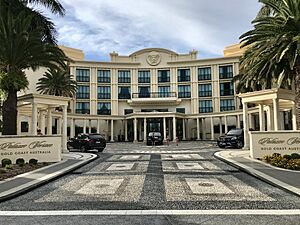
Gold Coast City has over 13,000 guest rooms. These bring in over $335 million to the local economy each year. You can find everything from hostels to five-star resorts. Tourist attractions include surf beaches and theme parks. These parks include Dreamworld, Sea World, Wet'n'Wild Water World, and Warner Bros. Movie World. Other popular spots are Currumbin Wildlife Sanctuary and David Fleay Wildlife Park.
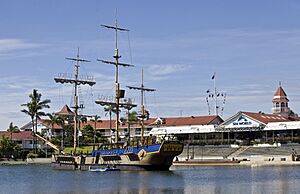
The Q1 building opened in 2005. It was once the world's tallest residential tower. It is a popular spot for tourists and locals. Its observation deck on level 77 is the highest in Queensland. It offers views from Brisbane to Byron Bay. The Q1 is 322.5 metres (1,058 feet) tall. It is the tallest building in Australia.
Another famous attraction is the Surfers Paradise Meter Maids. They started in 1965. They put coins into parking meters to prevent tickets. They also leave a calling card. The Maids are still a part of Surfers Paradise culture.
Chinatown, Gold Coast, in Southport, is important for making Southport an international business centre.
Film Production
The Gold Coast is a major film production hub in Queensland. It has been home to 75% of all film production in Queensland since the 1990s. This brings in about $150 million each year. The Gold Coast is Australia's third-largest film production centre.
Many major movies have been filmed here. These include Muriel's Wedding (1994), Scooby-Doo (2002), Superman Returns (2006), San Andreas (2015), Pirates of the Caribbean: Dead Men Tell No Tales (2017), Thor: Ragnarok (2017), and Aquaman (2018).
Village Roadshow Studios are next to the Warner Bros Movie World Theme Park. The studios have eight sound stages, offices, and workshops. These sound stages cover 10,844 square metres (116,724 square feet). This makes them one of the largest studio lots in the Southern Hemisphere.
Gold Coast Culture
The Gold Coast's culture has been shaped by its fast growth and focus on tourism. Despite these changes, there is a strong local culture. This includes things like surf culture. There is also a wider "Gold Coaster" identity.
The Gold Coast hosts many cultural activities for both tourists and locals.
Music
Music groups from this region include the Northern Rivers Symphony Orchestra. Musicians Cody Simpson and Ricki-Lee Coulter are from the Gold Coast. Music events include the Blues on Broadbeach Festival.
Arts
Home of the Arts (HOTA) is the Gold Coast's main cultural centre. It has a theatre, two cinemas, and an underground venue. The theatre has hosted performances by the Imperial Russian Ballet and The Australian Ballet. Musicals, plays, and other shows are regularly scheduled. The city also has the Gold Coast City Art Gallery. Film festivals and comedy clubs feature international artists. A new cultural area opened before the city hosted the 2018 Commonwealth Games.
Gold Coast Sport

The two most popular sports on the Gold Coast are Australian rules football and rugby league. The city has professional teams in both national competitions:
| Team name | Competition | Sport | Years |
|---|---|---|---|
| Gold Coast Titans | National Rugby League | Rugby league football | 2007–present |
| Gold Coast Suns | Australian Football League | Australian rules football | 2011–present |
The Burleigh Bears rugby league football club plays in the Queensland Cup. They have won four championships.
Popular activities on the Gold Coast include surfing, fishing, cycling, boating, and golf. The Gold Coast has many golf links, including Hope Island and Sanctuary Cove.
Sporting facilities include the Carrara Stadium, Carrara Indoor Sport Centre, and the Sports Super Centre. Newer facilities like the Gold Coast Sports and Leisure Centre have also been built.
Famous athletes from the Gold Coast include Olympic gold medal-winning swimmer Grant Hackett and tennis champion Samantha Stosur.
Commonwealth Games
The Gold Coast hosted the 2018 Commonwealth Games. This was a big international sports event for countries in the Commonwealth. It took place from April 4 to 15, 2018. It was the fifth time Australia hosted the Games. It was also the first time a major multi-sport event had an equal number of events for male and female athletes. More than 4,400 athletes from 71 countries took part.
Many venues were used for the Games. These included Carrara Stadium, Gold Coast Convention & Exhibition Centre, and Gold Coast Aquatic Centre.
Olympic and Paralympic Games
The Gold Coast will be one of three zones for the 2032 Summer Olympics and 2032 Summer Paralympics in Brisbane. It will use venues from the 2018 Commonwealth Games. The Gold Coast Zone will have seven venues. It will host nine Olympic and six Paralympic sports.
Other Events
The Gold Coast 500 is a car racing event held every year, usually in October. It takes place on the Surfers Paradise Street Circuit through the streets of Surfers Paradise and Main Beach.
Each June, Coolangatta hosts Cooly Rocks On. This is a two-week festival celebrating the 1950s and 1960s. It has free entertainment, hot rods, restored cars, and live music. Every July, over 25,000 people come to the Gold Coast for the Gold Coast Marathon. This is the city's largest annual community sports event.
In August, Currumbin hosts the annual Challenge Gold Coast triathlon. This event includes swimming in the Currumbin River, biking through the hinterland, and running along the beach.
Late November to early December is Schoolies week. Thousands of school leavers from across Australia come to the Gold Coast to celebrate. The City of Gold Coast hosts parties and events in Surfers Paradise. The Queensland Police Service and local volunteers work to ensure everyone has a safe and fun time.
Early each year, the Gold Coast hosts a leg of the ASP World Tour of surfing. Some of the world's best surfers compete in the Quiksilver Pro at Coolangatta.
The Arts Centre Gold Coast in Evandale has a fine art gallery. It shows local and international art. It also has a theatre for live shows and two cinemas for independent films.
Chinatown, Gold Coast, in Southport, hosts the annual Lunar New Year festival. It also has regular monthly events.
Gold Coast Media
The local daily newspaper is the Gold Coast Bulletin. The national surfing magazine Australia's Surfing Life is published in Burleigh Heads.
Major daily newspapers from Brisbane and Sydney are also available. These include The Courier-Mail and The Daily Telegraph. National newspapers like The Australian can also be bought.
Television
The Gold Coast receives television channels from both Brisbane and Northern NSW. These include Seven, Nine, and 10. The ABC and SBS are also available.
- Nine News has a local news bulletin at 5:30pm on weekdays. It broadcasts from studios in Surfers Paradise.
- NBN airs NBN News, an hour-long regional program. It includes local news for the Gold Coast.
Radio
There are many commercial, ABC, and community radio stations on the Gold Coast.
Local FM stations include 92.5 Triple M, Hit Network's 90.9 Sea FM, and Hot Tomato. ABC Gold Coast is the local ABC station. National ABC radio services like Triple J are also available.
Gold Coast Education
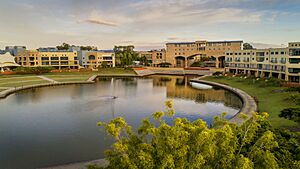
Colleges and Universities
The Gold Coast has two main university campuses. These are Bond University in Robina and Griffith University in Southport. Southern Cross University also has a smaller campus near the Gold Coast Airport. TAFE Queensland has five campuses in areas like Southport and Robina.
Schools and Libraries
There are over 100 primary and secondary schools on the Gold Coast. These include public and private schools. Queensland Academy for Health Sciences is a selective state high school. The Southport School and St Hilda's School are private single-sex schools. The oldest public school is Southport State High School, which opened in 1916. The Gold Coast also has many libraries.
Gold Coast Health
In 2018, about 61.6% of the city's population was overweight or obese.
Gold Coast Infrastructure
Utilities
Electricity Electricity for the Gold Coast comes from Powerlink Queensland. It is supplied from a large power system connected across several states. Energex distributes and sells electricity and natural gas to homes and businesses.
Water Supply The Hinze Dam, about 15 kilometres (9 miles) southwest of Nerang, is the main water source. The Little Nerang Dam also helps supply water. Both are managed by Gold Coast Water. The Gold Coast also gets water from Wivenhoe Dam near Brisbane for its northern suburbs when needed.
Some new Gold Coast homes have a dual water system. This provides highly treated recycled water for uses like gardening and flushing toilets. This is in addition to drinking water. The Gold Coast has been recognized for this system in its Pimpama-Coomera suburbs. Gold Coast Water can also supply up to 133 megalitres of desalinated water per day.
Transport
Cars are the main way people travel on the Gold Coast. Over 70% of people use a car to get to work. The Gold Coast has many main roads that connect coastal and inland suburbs. In recent years, governments have invested in transport to help with traffic. The Gold Coast has a good public transport network. This includes buses, heavy rail, and light rail.
Road
Several major roads connect the Gold Coast to Brisbane and New South Wales. The Pacific Motorway (M1) is the main highway. It goes through the inland Gold Coast and connects to the Pacific Highway at the NSW border. The Gold Coast Highway serves the coastal suburbs like Surfers Paradise and Southport. Other important roads include the Smith Street Motorway and Reedy Creek Road.
Light Rail
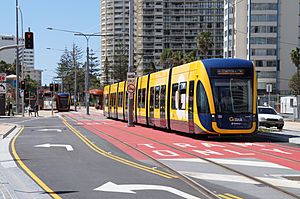
The Gold Coast's light rail service is called G:link. It is a 20-kilometre (12-mile) line between Helensvale and Broadbeach. It connects important areas like Southport and Surfers Paradise. The G:link opened in 2014. An extension to Helensvale was finished in 2017 for the 2018 Commonwealth Games.
Heavy Rail
Queensland Rail runs a train service from Brisbane to the Gold Coast. The line goes through stations like Coomera, Helensvale, and Robina. It ends at Varsity Lakes. There are plans to extend the line to the Gold Coast Airport.
Bus
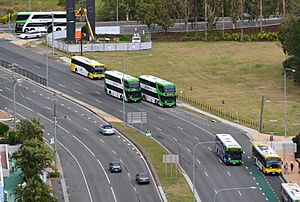
Kinetic Gold Coast operates all public bus services in the city. Services are frequent during the day. Kinetic has over 400 buses covering more than 70 routes across the city.
Airports
The main international airport is Gold Coast Airport. It is in Coolangatta, about 22 kilometres (14 miles) south of Surfers Paradise. It has flights to major Australian cities and international destinations like New Zealand and Singapore. In 2019, it was Australia's sixth busiest airport.
Smaller private airfields are in the northern suburbs. These are used for flight training and private planes.
Projects
- Stage 3 of the G:link Light Rail system to Burleigh Heads is being built. It is expected to open in 2025. Planning for Stage 4 is also underway. This stage is planned to open before the Brisbane 2032 Olympic Games.
- The existing heavy rail Gold Coast line will be extended to Coolangatta.
- The Pacific Motorway M1 is being upgraded.
Gold Coast Real Estate
The Gold Coast's real estate market is very active. It has luxury coastal homes, new housing developments, and investment chances. Property values have grown a lot recently. This is because of the lifestyle, closeness to Brisbane, and ongoing improvements to the city's infrastructure.
Notable People from Gold Coast
- Megan Anderson, MMA fighter
- Mackenzie Arnold, football goalkeeper for the Australia national team
- Jack Beeton, racing driver
- Harley Cameron, professional wrestler
- Aisha Dee, actress and singer
- Jack Doohan, racing driver
- Mick Doohan, five-time 500 cc Grand Prix motorcycle racing world champion
- Mick Fanning, surfer
- Broc Feeney, racing driver
- Zane Goddard, racing driver
- Lochie Hughes, racing driver
- Luke Mitchell, actor and model
- Lyndon Dykes, soccer player
- Sophie Monk, television personality and singer
- Nash Morris, racing driver
- Joel Parkinson, surfer
- Margot Robbie, actress
- Aiysha Saagar, pop singer
- Amy Shark, singer-songwriter and producer
- Cody Simpson, swimmer and singer
- Jack Smith, racing driver
- Toni Storm, professional wrestler
- Anna Torv, actress
- Jessica Watson, sailor
See also
 In Spanish: Gold Coast (Australia) para niños
In Spanish: Gold Coast (Australia) para niños


